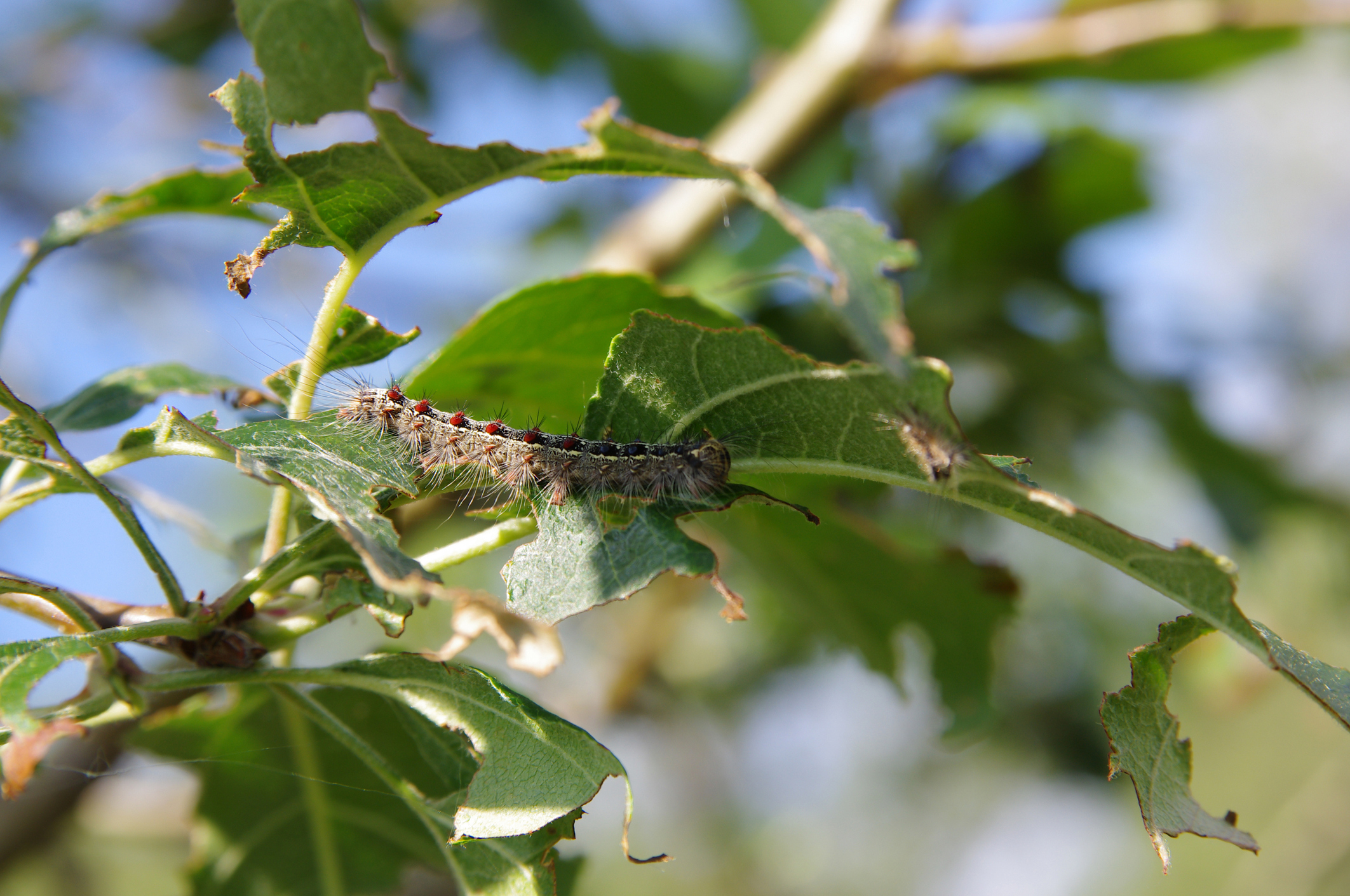As you step outside, pause for a moment to take in your surroundings. If you happen to be under a tree and hear what sound like rain drops, what you are hearing may be caterpillar droppings. More precisely, gypsy moth excrement. The gypsy moth population has soared this year, and it isn’t hard to spot these voracious pests crawling or dangling from trees, or the carpet of little brown pellets and shredded leaves that litter the ground after they have feasted in the dwindling treetops.
Thomas Worthley, a UConn extension educator for forest sustainability in the College of Agriculture and Natural Resources, offers some advice about these very hungry caterpillars and what we can expect next.
Can you tell us a little about the gypsy moth?
They are an invasive, non-native species that was introduced from Europe in the 19th century by someone hoping they would be useful for silk production. As with many things brought in that way, they didn’t realize they were importing a pest. They were brought to Massachusetts, escaped, and have been spreading over the eastern part of the country ever since.
Why are the moths so bad this year?
The gypsy moths have been getting worse for a couple of years now. They are cyclical and come in waves, every 7 to 10 years or so. The last bad wave was in the early 1980s and after that infestation, a fungus came onto the scene that helps keep the population in check by causing a fungal disease in the caterpillar. However, this fungus requires a lot of moisture, and the last couple of growing seasons have been very dry in May and June so the fungus wasn’t particularly effective. Rather than the typical small infestations we usually see, we had a tremendous number of moths that laid eggs last year, and this year we have millions and millions of caterpillars hatching this spring. Although we have had a wet spring, the fungus hasn’t kicked in yet.
How concerned should we be about the damage the caterpillars are causing?
We’re expecting some defoliation, or loss of leaves, but most of those trees will leaf out again. There are some that have been repeatedly stressed and defoliated, but we do expect to see those trees refoliating.
Which trees are most at risk?
It’s a matter of location and of preference. The first favorite food source for the moths is the white oak, followed by the red oak. Trees lower in the canopies will be more susceptible because the caterpillars will eat whatever they come to first. About the only species they won’t attack is the Tulip or Yellow Poplar trees. In heavy infestations those tend to be the only green you will see left. Pines are more at risk because if the gypsy moths eat the needles, the trees will die. Deciduous trees should refoliate for the most part.
What can we do now to help the trees survive?
Right now, it’s pretty much a waiting game. I had two small white pines I was concerned about losing the needles on. I took wide strips of tape and put those around the trunks sticky side out, that helped somewhat because the caterpillars would not cross the sticky surface of the tape. Also, spraying with very soapy water will kill the caterpillars, it keeps them from breathing. Anywhere you see the caterpillars, try spraying them down. It is hard to get them all but this will help somewhat. Horticultural oils accomplish the same thing that soap will. There are a variety on the market that can be helpful.
For trees that are extremely tall, 70 to 80 feet or so, it’s really a matter of waiting it out. Most of these trees will refoliate, and should have a normal summer by mid-July. If the tree doesn’t have the energy to send out new leaves, you should make arrangements to get it removed.
Healthier trees will be more resilient in general. Making sure the trees have plenty of moisture available when they are ready to put out leaves is important. Also, a tree with space will be a healthier tree. Identify the trees you want to help and be sure they aren’t competing with other plants. Be careful of the roots, don’t compact the soil, and avoid damaging the roots with machinery or weed whackers. Avoiding root system damage is very important to keep your tree healthy. Also, don’t over-mulch. Mulching too much, too close to the trunk is very bad for the tree.
How do you expect the gypsy moth to impact the UConn Forest?
At the UConn Forest we are keeping an eye on things, just like everyone else. If there is die off, we will plan some salvage activity. The bigger problem that we are thinking about is a different pest, the Emerald Ash borer, and that will have an impact on the UConn Forest.
Homeowners can find answers to any further questions on gypsy moths through the UConn Home and Garden Center.
Update, June 26, 2017:
This week, dead gypsy moth caterpillars have begun appearing at the base of trees, killed by the naturally-occurring fungus Entomophaga maimaiga. The rainy weather in May and June helped the fungus to develop. As the caterpillars decompose, the fungus reproduces inside the cadavers and on the ground around the trees. It will spread farther in the area and can persist in the soil for many years.
“We recommend that property owners leave the caterpillars in place on the trees to allow the fungus to continue to develop and spread naturally,” says Donna Ellis, senior extension educator at UConn.
“It remains to be seen how successful the fungus will be in reducing future gypsy moth populations,” she adds, “but hopefully it will have an impact.”
For more information, see page 2 of the June 23 UConn Nursery and Landscape Update.



